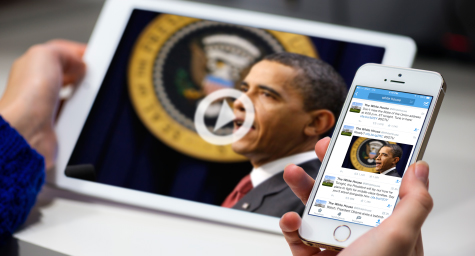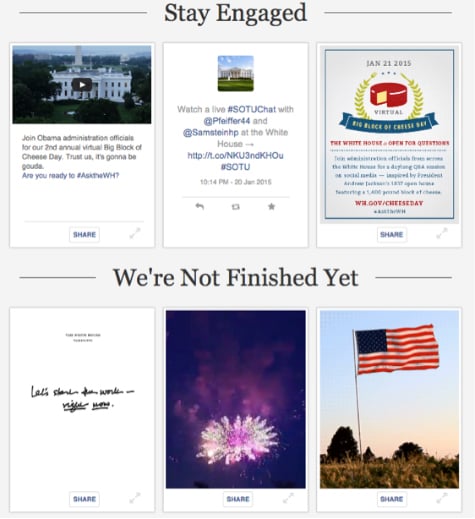How the White House Made the State of the Union Social #RiverOfContent
A few weeks ago the White House received a handwritten letter from a young boy thanking President Obama for giving “those long boring” State of the Union speeches which “people are just texting” through.
That sentiment was probably shared by many Americans, as the State of the Union address has become pretty predictable; the President talks about his vision, Congress occasionally claps, and the public somewhat listens (at least since live radio broadcasts were introduced in the 1940s).
However, what happened next with the kid’s note was far from conventional—and it signaled a new approach to the speech. Rather than simply replying privately, the White House Instagramed the letter, added links and hashtags, and got 13,000 likes.
That response highlights how this year’s State of the Union address was unlike any other. To spark interest and action, the White House openly worked to turn the speech into a social media happening, with a full-on content blitz across multiple social media networks and on the WhiteHouse.gov website.
The depth and scale of the effort was truly impressive, and it serves as an excellent example of how to build social engagement before, during, and after an event.
Here are a few of the (many, many, many) ways the White House worked to make this #SOTU social:
Pre-Speech
There was quite a bit of pre-speech utility content from the White House on social media—reminders on how and when to watch, as well as teasers of the core policy proposals.
However, what was different, and what got the highest engagement, was the behind-the-scenes content. As the address was being drafted, the White House’s Facebook, Twitter, and Instagram feeds gave intimate glimpses into speechwriters at work and the final version being readied.
To humanize these posts, various staffers “took over” the social media accounts for a day, explaining how they were part of the process. This included Fiona Reeves, the Director of Presidential Correspondence, showing how letters from citizens influence the speech:
Right before the speech, White House also had a bit of fun trolling the Twitterverse by hinting the President might wear a tan suit (he didn’t):
President Obama’s suiting up for the big speech. Watch at 9pm ET → http://t.co/NKU3ndKHOu #YesWeTan pic.twitter.com/l7EJZYVk9s
— The White House (@WhiteHouse) January 21, 2015
During the Speech
As in the past, the White House streamed the State of the Union on its website and on YouTube, ensuring that it could be seen by as many people as possible. However, this year the live online effort went beyond delivery and also included engagement elements. Before the speech, the White House announced that an “enhanced” version of the address would be presented on WhiteHouse.gov, accompanied by “a river of content.” What exactly is a river of content? As the address was delivered, it became clear. Each policy element was accompanied by a set of short, visual cards—including photos, quotes, calls-to-action, bits of news, and even interactive widgets.
The key to success was that each card was posted immediately to Twitter, and was easily shareable across other networks. As the speech went on, this led to the posting, retweeting, favoriting, and liking of hundreds of pieces by thousands of people—turning the river of content into a flood.
“In the past year…about 10 million uninsured Americans finally gained the security of health coverage.” —Obama pic.twitter.com/nEK5h96QtV
— The White House (@WhiteHouse) January 21, 2015
However, though the “river” did very well, the most tweeted content during the speech wasn’t actually pre-planned piece; it was President Obama’s (seemingly) off-the-cuff joke about winning two elections:
“I have no more campaigns to run. I know because I won both of them.” —President Obama #SOTU
— The White House (@WhiteHouse) January 21, 2015
After the Speech
The river of content didn’t dry up at the end of the State of the Union address. The White House continued to post pieces—including quotes, photos, and even animated GIFs—urging further action.
In a nod to both past tradition and the West Wing TV show, the White House also scheduled a Big Block of Cheese Day for this Friday (“It’s Feta Than Ever”), making administration members available to answer questions on social media about the State of the Union and issues in general.
Finally, three YouTube stars—GloZell Green, Bethany Mota, and Hank Green—were picked to interview President Obama about the speech live this Thursday, with questions coming from both the vloggers and people using the #YouTubeAsksObama hashtag.
So, did all this social media outreach pay off? The numbers are just coming in, but it seems to have. Twitter says there were 2.6 million tweets around the #SOTU hashtag, and Facebook estimates 5.7 million users had 13.8 million interactions about the address. Not too shabby for a “long boring speech.”
Tap into the latest social media tactics. Contact MDG.
MDG, a full-service advertising agency with offices in Boca Raton and New York, NY, is one of Florida’s top branding firms. MDG’s capabilities include print advertising, direct mail marketing, branding, logo design, creative, digital marketing, media buying and planning, radio and TV advertising, Web design and development, online video advertising, infographic development, email marketing, mobile marketing, content marketing, social media marketing, paid search marketing, and SEO. To learn about the latest trends in advertising and branding, contact MDG.


